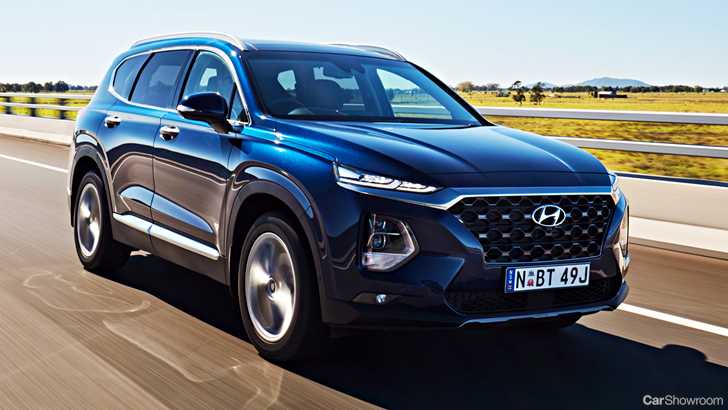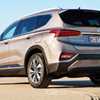Hyundai’s got game.
It’s the era of the SUV, and Korean marque Hyundai knows that it has to do everything it can to capitalise on that. The compact-SUV space has been addressed by the quirky Kona, and now the opposite end of the spectrum has this, the Santa Fe.
The Hyundai Santa Fe is not new to Australia, with the first of them arriving back in 2000. Back then, it was one of the most value-packed SUVs, and proved to be pretty reliable in the following two (more) generations kept to the same recipe. But now in its fourth generation, the Santa Fe is more than that. It’s now smart, upmarket, efficient, and bold.
That new face is love/hate really, but when you look past that, it makes a lot of sense. There are three grades on offer, with an atmospheric 2.4-litre petrol mill on the base model and a 2.2-litre turbodiesel for the Elite & Highlander models, though they all have all-wheel drive and automatic gearboxes. It’s now also bigger than the outgoing car, more practical, and an overall greater package.
With prices starting at $43k and rising to a whisker over $60k, the Santa Fe looks good not only in isolation, but even when considered against rivals like the new Mazda CX-8, Kia Sorento, and the Skoda Kodiaq, the Santa Fe remains unshaken. We take a closer look at Hyundai’s flagship model.
Exterior
“This new-generation Santa Fe looks totally different to the previous model, inside and out.” — CarsGuide
It was the Kona that set the pace for Hyundai’s SUV design language, and the Santa Fe’s taken that template and reinterpreted it rather handsomely in this much larger application. Given that it’s a more upmarket model, Hyundai’s gone to town with the details, like the student grille and full-width chrome element that stretches over the grille and under the upper light units (that house the daytime running lights).
The grille itself, aside from the studs, needs to be talked about. Hyundai’s said that it’ll apply its signature ‘cascading grille’ differently with every model, and it looks really smart on the Santa Fe. The angle of the grille’s sides are mirrored by the main light units which sit below that chrome ‘slash,’ while the lower grille is underscored by a skid plate.
Move down the sides and you’ll notice the prominent black body cladding that covers the lower edge of the car, and around the wheelarches. We quite like the surface play that Hyundai’s incorporated to break up the visual bulk of the Santa Fe; This is a big car, but it doesn’t look as big as it is. The glasshouse of the 4th-gen model has been made some 40% larger than the outgoing car, and it’s been done without impacting the aesthetics. Glad it doesn’t look like a greenhouse.
At the rear you’ll find LED taillights with a neat three-dimensional graphic to them, but the indicator & reverse lights are housed in a separate arrangement set in the bumper, which is rather odd to look at no matter how you cut it. No matter the angle it’s hard to escape the presence of the Santa Fe: It’s a thoroughly modern machine and it certainly looks it. Whether it’s as pretty as a Mazda CX-8 or as butch as the Kia Sorento is a matter of opinion but to us, it’s a bold & characterful entrant in the segment.
Engine & Drivetrain
“Despite the lack of engine idle-stop technology and with arguably-outmoded petrol engine technology… both of the Santa Fe’s mills managed respectable fuel economy on test.” — Motoring
The Hyundai Santa Fe comes in two flavours for our market, with a 2.4-litre atmo petrol engine available for the Active model, and a 2.2-litre turbodiesel reserved for the Elite & Highlander grades. The two mills also use different automatic transmissions, but power goes to all four wheels regardless.
In the base Active model, you get that aforementioned 2.4-litre petrol engine, producing a pretty average 138kW and 241Nm. A six-speed automatic puts power down to all four corners in a smooth, unobtrusive way, though there’s an underlying feeling that it’s been tailored for fuel efficiency rather than engagement. The official fuel economy suggests that too, with 9.3L/100km claimed consumption on official testing not that far off the mid-10L/100km you’ll expect to see in real life.
But in terms of outright versatility, you have to hand it to the diesel engine. The 2.4-litre R-series turbodiesel puts out a far healthier numbers, rated at 147kW and 440Nm, while the 8-speed automatic gearbox employed is a real joy to use. It’s fast and intuitive, and the wide spread of ratios means that it’s always ready to make full use of the torque on hand to balance performance and efficiency deftly. This shows in the fuel economy ratings: Officially it’ll drink just 7.5L/100km though in reality, you’ll probably see something like 8.5L/100km.
Interior
“Overstyled plastics, undersized rear-window apertures, and overbearing ride firmness are now distant memories for the newly mature Santa Fe. It’s goodbye ‘Gangnam Style’ and hello Broadway.” — Wheels
Hyundai used to try a bit too hard in the cabin with their ‘adventurous’ designs, which were only made worse by the use of economy-grade plastics and questionable build quality. Thankfully the company’s turned a page, and that’s abundantly evident inside the Santa Fe. There’s a newfound sense of maturity and sensibility inside, evident from the general architecture of the cabin and the colour schemes employed.
But it’s not all show though: Poke and prod and you’ll find soft, malleable plastics used on major touchpoints, with harder, less forgiving materials employed only in places you wouldn’t normally interact with. For a mass-market car this is pretty impressive, and while it might be a little way off what you’d get in a Skoda Kodiaq or a Tiguan Allspace, it’s really not bad.
It’s the little things that really set the Santa Fe’s dash off, like the separate wrap-around instrument cowls and the ‘stitch-effect’ on the dash trim. Infotainment is handled by a ‘floating’ touchscreen that you either love or hate, but is easy to use in operation and is presented rather nicely. Space is abundant in the Santa Fe regardless of which row you’re in, with the third-row of seats even just about doable for an adult if the second-row passengers agree to give up some of their legroom.
But, with all three rows of seats up, practicality’s been improved. The 130L rated space behind the third row is decent enough for the weekly groceries, while folding down the rearmost pews frees up 547L of room for lots of luggage and whatever else you’d need to bring with you. Fold all 5 rear seats and you’re rewarded with 1625L which is so cavernous, you could reconsider hiring a van for your next move.
Behind The Wheel
“We had the chance to sample all three model grades on a challenging set of roads, and came away largely impressed.” — Drive
Something that Hyundai prides itself on is the amount of money and expertise it invests into tuning its Australian-market cars, and the Santa Fe is a product of that investment. No matter how bad the surface the Santa Fe just shrugs it off with little concern. It’s comfortable over the worst any city street can throw at it, and the Santa Fe’s impressive build quality means you won’t hear rattles or clunks either.
But out on the motorway, the ride goes from comfortable to confident, with the Santa Fe demonstrating its willingness to be used as a family cruiser. With comfy seats, precious little wind noise or tyre roar, the Santa Fe will keep you going for miles and miles without issue. This is helped by that torquey turbodiesel engine, which always has a huge amount of torque in reserve for overtaking and hills. Opt for the petrol engine and you’ll hear a bit more of it on the motorway, though in town, it’s a pretty hushed engine.
Body roll is pretty well controlled despite what the comfy ride might suggest, but it certainly won’t set your heart on fire. As we said earlier, the Santa Fe is a car that gives you confidence on the road, but don’t mistake that to mean that it’s about to challenge cars like the Mazda CX-8 on a twisting coast road. But that said, Hyundai’s priding itself on its ride & handling attributes these days, so a future model might be quite an accomplished B-road barnstormer.
Between the two engines our recommendation definitely lies with the diesel. While it might be a bit noisier under acceleration, the 8-speed auto and masses of torque mean you’ll very rarely need to strain it, and in town its quick responses won’t ever leave you floundering.
Safety & Technology
“Safety is a big priority for Hyundai…” — CarAdvice
The Hyundai Santa Fe is, more than anything else, a family SUV. As such, it’s no surprise that the big Korean comes with an impressive list of standard kit. All cars get things like a reversing camera and rear parking cameras, though Elite models get front sensors and the Highlander comes with a 360º camera.
Autonomous emergency braking is also standard across the range, and it’s capable of detecting pedestrians & cyclists at speeds of up to 90km/h, while it’s functional with cars up to 160km/h. Active cruise control, blind-spot monitoring, rear cross-traffic alert, driver-drowsiness alert, lane-keep assist, and a tyre-pressure monitoring system.
In Elite & Highlander variants there’s also a new system called ‘Rear Occupant Alert,’ a system born from situations where parents forget they have a child or a pet in the car with them. By detecting pressure on the back seats, cars with ROA will remind drivers with a visual & audible warning inside the car when they turn the car off. If drivers still exit & lock the vehicle, an alarm will go off after a certain time, theoretically alerting drivers to a passenger still in the back seat.
The whole range also benefits from standard Apple CarPlay and Android Auto, though the infotainment screens differ. Entry Active models get a 7.0-inch touchscreen unit, while Elite & Highlander cars get a nicer 8.0-inch unit with satellite navigation. However, only Highlander cars get a 7.0-inch digital display ahead of the driver, which compliments a heads-up display that shows things like your speed as well as navigation prompts.
Verdict
The Hyundai Santa Fe has always been a consummate family car, offering practicality, reliability, and comfort that family life needs. But in this fourth generation, Hyundai’s big SUV has really improved its game and has fielded an entrant that is also boldly designed, premium inside, and confident on the road. Importantly, the Santa Fe also serves to show the brands’ intent to go upmarket, and it does so in spectacular fashion.
Korean cars used to be a left-field choice, and while they’ve become massively popular since then, the Santa Fe’s greatest appeal actually comes from that left-field vibe that it still gives off thanks to that unconventional face. The best part perhaps of the Santa Fe is that that look doesn’t come at the cost of a shabby cabin and outdated mechanicals, because no matter where you look, the Santa Fe impresses.
Of the three variants available, we’d rally around the mid-range Elite model. It’s got all the kit you need, looks the business, and doesn’t really cost an arm and a leg. And most importantly, it’s got that torquey 2.2-litre turbodiesel mill which not only does better on fuel, but gives the Santa Fe a greater spread of ability.
Visit the Hyundai showroom and get the best deals on a brand-new Santa Fe here.
CarsGuide — 7.9/10 — “The previous generation Hyundai Santa Fe was excellent, and this giant leap forward in design and technology has turned it into something better. Not overly large, but seven seats and great storage make it super practical, the new suspension makes it pleasure to drive, and a new look inside and out takes the Santa Fe’s refinement to the next level. It doesn’t matter what this SUV is called because it’s exceptional.”
Motoring — 78/100 — “Hyundai has really raised the bar on its popular seven-seat SUV. The new Santa Fe is bigger, better-equipped and safer than it’s ever been before, yet remains a quality family-hauler that’s easier to park, position and drive than a lot of its larger contemporaries.”
CarAdvice — 8.4/10 — “We've been seriously impressed by the new Hyundai Santa Fe. It delivers on style, interior packaging, the latest safety technology and competitive pricing. It's a shame there isn't an entry-level front-wheel-drive model or the retention of a petrol V6, but it paves the way to a healthy line-up down the track.”
Drive — 7.5/10 — “… the fourth-generation Santa Fe is a classy, convenient, and comfortable family car that now offers a sense of style to match the substance of its predecessor. It’s a car that continues to forge a new perception for the brand and banish its old reputation.”
WhichCar — 4.0/5.0 — “After its handling-biased, one-trick-pony predecessor and two earlier generations of dull-but-dependable dross, the new-gen Santa Fe shines like Centrepoint tower above Sydney’s skyline. Handsome, roomy, excellent to drive and lovingly crafted, it’s the polar opposite of its contrived and plasticky forebears. The brawny eight-speed diesel has all its ducks in a row, and the $60K Highlander has enough visual swagger to support its price-tag, though if it’s V6 petrol power you’re after – or Mazda CX-9-rivalling thrust – you’ll need to shop elsewhere.”













































